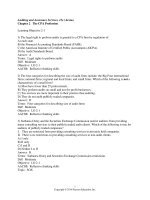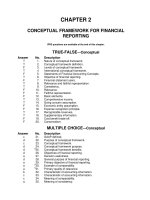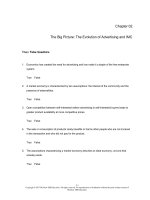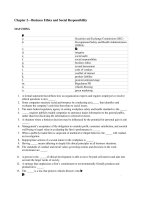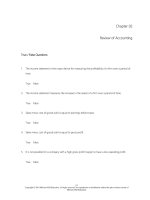Abnormal psychology 15th edition butcher test bank
Bạn đang xem bản rút gọn của tài liệu. Xem và tải ngay bản đầy đủ của tài liệu tại đây (579.57 KB, 39 trang )
TOTAL
ASSESSMENT
GUIDE
Chapter 2: Historical and Contemporary
Views of Abnormal Behavior
Topic
Historical Views of
Abnormal Behavior
Toward Humanitarian
Approaches
The Emergence of
Contemporary Views of
Abnormal Behavior
Factual
Conceptual
Applied
7, 17, 18, 19, 20, 22,
25, 27
9, 11, 13, 26, 31
36, 48, 53, 57, 61, 66,
67
38, 60, 63, 65, 71, 72
Blank (2.2-)
1, 2, 3, 4, 5, 6, 8, 10,
12, 14, 15, 16, 21,
23, 24, 28, 29, 30,
32
1
1, 2
1
33, 34, 35, 37, 39,
40, 41, 42, 43, 44,
45, 46, 47, 49, 50,
51, 52, 54, 55, 56,
58, 59, 62, 64, 68,
69, 70, 73, 74, 75,
76, 77
2, 3
Short Answer (2.3-)
4, 5, 6, 8,
9
7
Essay (2.4-)
Multiple Choice (2.1-)
2
78, 81, 83, 84, 85,
86, 87, 88, 89, 91,
93, 94, 95, 97, 98,
102, 105
4
11, 13
5
82, 103, 104, 106
79, 80, 90, 92, 96, 99,
100, 101
10, 14
4
12
3
Multiple Choice (2.1-)
Blank (2.2-)
Short Answer (2.3-)
Essay (2.4-)
Multiple Choice (2.1-)
Blank (2.2-)
Short Answer (2.3-)
Essay (2.4-)
3
Copyright © 2013 by Pearson Education, Inc. All rights reserved.
38
Chapter 2: Historical and Contemporary Views of Abnormal
Behavior
Multiple-Choice Questions
2.1-1. Archaeology and early writing indicate that the first people to think
that the brain was the site of mental functions were the
a. ancient Egyptians.
b. ancient Greeks.
c. Chinese.
d. Hebrews.
Difficulty: 2
Question ID: 2.1-1
Page Ref: 30
Topic: Historical Views of Abnormal Behavior
Skill: Factual
Answer: a. ancient Egyptians.
2.1-2. Early writings show that the Chinese, Egyptians, Hebrews, and Greeks often
attributed abnormal behavior to
a. poor parenting.
b. physical disease.
c. demonic possession.
d. chemical imbalance in the brain.
Difficulty: 2
Question ID: 2.1-2
Page Ref: 31
Topic: Demonology, Gods, and Magic
Skill: Factual
Answer: c. demonic possession.
2.1-3. In ancient societies, if a person's abnormal conduct consisted of speech that
appeared to have a religious or mystical significance, then the person was
a. assumed to have willingly entered into a pact with the devil.
b. thought to be a witch.
c. thought to be possessed by a good spirit or god.
d. assumed to have something physically wrong with the heart.
Difficulty: 2
Question ID: 2.1-3
Page Ref: 31
Topic: Demonology, Gods, and Magic
Skill: Factual
Answer: c. thought to be possessed by a good spirit or god.
2.1-4. Prayer, incantations, and noise-making were all techniques for
a. altering a person's brain functioning.
Copyright © 2013 by Pearson Education, Inc. All rights reserved.
39
b. improving a person's dreams.
c. helping a person become possessed by good spirits.
d. exorcising demons.
Difficulty: 1
Question ID: 2.1-4
Page Ref: 31
Topic: Demonology, Gods, and Magic
Skill: Factual
Answer: d. exorcising demons.
2.1-5. According to Hippocrates, mental disorders were part of which three general
categories?
a. Schizophrenia, mania, and melancholia.
b. Schizophrenia, mania, and phrenitis.
c. Melancholia, mania, and phrenitis.
d. Melancholia, mania, and anxiety.
Difficulty: 1
Question ID: 2.1-5
Page Ref: 31
Topic: Hippocrates’ Early Medical Concepts
Skill: Factual
Answer: c. Melancholia, mania, and phrenitis.
2.1-6. Each of the following is one of the "four humors" EXCEPT
a. blood.
b. phlegm.
c. phrenitis.
d. bile.
Difficulty: 1
Question ID: 2.1-6
Page Ref: 31
Topic: Hippocrates' Early Medical Concepts
Skill: Factual
Answer: c. phrenitis.
2.1-7. The belief in the four humors as a means of explaining temperament
a. is inconsistent with a biological explanation for mental illness.
b. has yet to be disproven.
c. proposed that mental disorders were the result of an imbalance.
d. provides that first indication that ancient people recognized the significance of
the brain in determining behavior.
Difficulty: 2
Question ID: 2.1-7
Page Ref: 31
Topic: Hippocrates' Early Medical Concepts
Skill: Conceptual
Copyright © 2013 by Pearson Education, Inc. All rights reserved.
40
Answer: c. proposed that mental disorders were the result of an imbalance.
2.1-8. The doctrine of the four humors
a. was an attempt to support moral management.
b. was an explanation for personality traits.
c. was an early suggested treatment for melancholy.
d. was the first psychological explanation of mental disorders.
Difficulty: 2
Question ID: 2.1-8
Page Ref: 31
Topic: Hippocrates' Early Medical Concepts
Skill: Factual
Answer: b. was an explanation for personality traits.
2.1-9. According to early beliefs, what would characterize an individual with an
excess of blood?
a. Depression
b. Schizophrenia
c. Irritability
d. Cheerfulness
Difficulty: 2
Question ID: 2.1-9
Page Ref: 31
Topic: Hippocrates' Early Medical Concepts
Skill: Applied
Answer: d. Cheerfulness
2.1-10. Hippocrates suggested marriage as a cure for
a. impotence.
b. hysteria in women.
c. phrenitis (brain fever) in men.
d. melancholia.
Difficulty: 1
Question ID: 2.1-10
Page Ref: 31
Topic: Hippocrates' Early Medical Concepts
Skill: Factual
Answer: b. hysteria in women.
2.1-11. Cicero was feeling depressed. He sought help from Hippocrates. Hippocrates
would probably have
a. prescribed the roots of certain plants and unusual elixirs.
b. utilized a talking cure.
c. prescribed exercise, tranquility, and celibacy.
d. performed an exorcism.
Difficulty: 2
Copyright © 2013 by Pearson Education, Inc. All rights reserved.
41
Question ID: 2.1-11
Page Ref: 32
Topic: Hippocrates' Early Medical Concepts
Skill: Applied
Answer: c. prescribed exercise, tranquility, and celibacy.
2.1-12. According to your textbook, which mental disorder received the most
attention from early scholars?
a. Phobias
b. Depression
c. Schizophrenia
d. Multiple personality disorder
Difficulty: 2
Question ID: 2.1-12
Page Ref: 32
Topic: Melancholia Through the Ages
Skill: Factual
Answer: b. Depression
2.1-13. Plato was one of the first to argue for
a. medical treatment of mental illness.
b. demonic possession in mental illness.
c. different punishments for mentally disturbed individuals.
d. the use of bleeding as a treatment for mental illness.
Difficulty: 2
Question ID: 2.1-13
Page Ref: 33
Topic: Early Philosophical Conceptions of Consciousness
Skill: Applied
Answer: c. different punishments for mentally disturbed individuals.
2.1-14. Aristotle believed that
a. mental disorders could be caused by psychological factors.
b. mental disorders could not be caused by psychological factors.
c. bodily fluids had nothing to do with mental illness.
d. mental illness was due to demonic possession.
Difficulty: 2
Question ID: 2.1-14
Page Ref: 33
Topic: Early Philosophical Conceptions of Consciousness
Skill: Factual
Answer: b. mental disorders could not be caused by psychological factors.
2.1-15. One of Aristotle's major contributions to psychology was
a. his belief that dreams explained most mental disorders.
b. his theory that psychological disorders were due to psychological rather than
Copyright © 2013 by Pearson Education, Inc. All rights reserved.
42
physical factors.
c. his description of personality traits.
d. his description of consciousness.
Difficulty: 2
Question ID: 2.1-15
Page Ref: 33
Topic: Early Philosophical Conceptions of Consciousness
Skill: Factual
Answer: d. his description of consciousness.
2.1-16. The physicians of Alexandria, Egypt, in the era after Alexander the Great
were most likely to treat mental patients by
a. putting them in prisons.
b. using brutal forms of exorcism.
c. having them make sacrifices to gods.
d. providing activities, massage, and education.
Difficulty: 2
Question ID: 2.1-16
Page Ref: 33
Topic: Later Greek and Roman Thought
Skill: Factual
Answer: d. providing activities, massage, and education.
2.1-17. What is Galen credited with?
a. Providing the first biological explanation for mental disorders
b. Performing the first human autopsies
c. Demonstrating that the doctrine of the four humors was flawed
d. Recognizing that psychological disorders could have both biological and
psychological causes
Difficulty: 2
Question ID: 2.1-17
Page Ref: 33
Topic: Later Greek and Roman Thought
Skill: Conceptual
Answer: d. Recognizing that psychological disorders could have both biological and
psychological causes
2.1-18. Chung Ching wrote two well-known medical works around A.D. 200 and has
been referred to as the ____________ of China.
a. Aristotle
b. Galen
c. Plato
d. Hippocrates
Difficulty: 2
Question ID: 2.1-18
Page Ref: 34
Copyright © 2013 by Pearson Education, Inc. All rights reserved.
43
Topic: Early Views of Mental Disorders in China
Skill: Conceptual
Answer: d. Hippocrates.
2.1-19. Compared to the West, in the Chinese "Dark Ages," views of mental illness
a. began at a more sophisticated level but regressed, like the West, to belief in the
supernatural forces, although not for as long or with as negative a reaction to
patients.
b. began at a less sophisticated level but regressed, like the West, to belief in the
supernatural forces, although they regressed earlier and with a more negative
reaction to patients.
c. always believed that mental illness was due to supernatural forces. This belief
is still prevalent in China.
d. were always more sophisticated than the West; the focus was always on
medical causes and humane treatment.
Difficulty: 2
Question ID: 2.1-19
Page Ref: 34
Topic: Early Views of Mental Disorders in China
Skill: Conceptual
Answer: a. began at a more sophisticated level but regressed, like the West, to belief in
the supernatural forces, although not for as long or with as negative a reaction to patients.
2.1-20. Which statement about treatment of abnormal behavior in the Middle Ages
is accurate?
a. Although the Hippocratic tradition was continued in most of Europe, Islamic
countries emphasized demonology.
b. Scientific reasoning and humane treatments were valued in both European and
Islamic societies.
c. Islamic forms of treatment were more humane than European approaches.
d. The Chinese emphasized prayer, the Europeans emphasized exercise, and the
Islamic peoples emphasized balancing the four bodily humors.
Difficulty: 2
Question ID: 2.1-20
Page Ref: 34
Topic: Views of Abnormality During the Middle Ages
Skill: Conceptual
Answer: c. Islamic forms of treatment were more humane than European approaches.
2.1-21. The approaches to treatment of the mentally ill during the Middle Ages in
Europe are best characterized as
a. superstitious.
b. humane.
c. medical.
d. scientific.
Difficulty: 1
Copyright © 2013 by Pearson Education, Inc. All rights reserved.
44
Question ID: 2.1-21
Page Ref: 34
Topic: Views of Abnormality During the Middle Ages
Skill: Factual
Answer: a. superstitious.
2.1-22. What trend was observed during the Middle Ages in Europe?
a. Belief in theology was declining.
b. Approaches to mental disorders were becoming increasingly scientific.
c. Supernatural explanations for mental disorders grew in popularity.
d. Humane treatments were developed.
Difficulty: 2
Question ID: 2.1-22
Page Ref: 34
Topic: Views of Abnormality During the Middle Ages
Skill: Conceptual
Answer: c. Supernatural explanations for mental disorders grew in popularity.
2.1-23. What is "mass madness"?
a. An exhibition of disordered behavior by a group of people that appears to be
caused by hysteria
b. A reaction to the harsh and inhumane treatment of the mentally ill during the
Middle Ages
c. A reference to the increased incidence of schizophrenia seen 16 years after a flu
epidemic
d. A reaction to hallucinogenic compounds taken as part of religious rituals in
ancient Egypt
Difficulty: 2
Question ID: 2.1-23
Page Ref: 35
Topic: Views of Abnormality During the Middle Ages
Skill: Factual
Answer: a. An exhibition of disordered behavior by a group of people that appears to
be caused by hysteria
2.1-24. What is lycanthropy?
a. A form of mass hysteria characterized by wild dance-like movements
b. A condition in which people believe themselves to be possessed by wolves
c. A form of mass madness seen only in men
d. A form of mass hysteria now known to have been drug-induced
Difficulty: 2
Question ID: 2.1-24
Page Ref: 35
Topic: Views of Abnormality During the Middle Ages
Skill: Factual
Answer: b. A condition in which people believe themselves to be possessed by wolves
Copyright © 2013 by Pearson Education, Inc. All rights reserved.
45
2.1-25. The fact that episodes of mass madness peaked at the time of the Black
Death illustrates that
a. mass hysteria usually has a biological basis.
b. mental and physical illnesses commonly occur together.
c. phenomena that impact the society and its structure may also affect mental
health.
d. mental illnesses really are caused by imbalances in the four bodily humors.
Difficulty: 2
Question ID: 2.1-25
Page Ref: 35
Topic: Views of Abnormality During the Middle Ages
Skill: Conceptual
Answer: c. phenomena that impact the society and its structure may also affect mental
health.
2.1-26. In 1983, a large group of West Bank Palestinian girls showed signs of illness.
Some thought they were poisoned, but later it was discovered that psychological
factors played a key role in most cases. This incident best illustrates
a. St. Vitus's dance.
b. exorcism.
c. lycanthropy.
d. mass madness.
Difficulty: 1
Question ID: 2.1-26
Page Ref: 35
Topic: Views of Abnormality During the Middle Ages
Skill: Applied
Answer: d. mass madness.
2.1-27. The disorder Koro, where males fear that their genitals have retracted into
their body, possibly leading to death, is similar to the episodes of mass madness
during the Black Death because
a. both demonstrated that mass madness is primarily a physiological disorder.
b. both demonstrated the effect that sociocultural stressors can have on mental
functioning of large groups of people.
c. both demonstrated that the responses of other people to the person with mass
madness determines whether the person will recover.
d. both demonstrated that it is extremely difficult, if not impossible, to discover
the cause of mass madness.
Difficulty: 3
Question ID: 2.1-27
Page Ref: 35
Topic: Views of Abnormality During the Middle Ages
Skill: Conceptual
Answer: b. both demonstrated the effect that sociocultural stressors can have on mental
Copyright © 2013 by Pearson Education, Inc. All rights reserved.
46
functioning of large groups of people.
2.1-28. A common treatment for mental illness during the Middle Ages in Europe
was
a. exorcism.
b. fresh air and supportive surroundings.
c. banishment.
d. an early form of psychoanalytic dream interpretation.
Difficulty: 1
Question ID: 2.1-28
Page Ref: 35
Topic: Views of Abnormality During the Middle Ages
Skill: Factual
Answer: a. exorcism.
2.1-29. Recent historical reviews of the literature indicate that the typical accused
witch in the Middle Ages in Europe was
a. a person we would now consider to have a mental illness.
b. a priest who was a rival of a more powerful priest.
c. an ill-tempered, impoverished woman.
d. a person we would now consider to have mental retardation.
Difficulty: 2
Question ID: 2.1-29
Page Ref: 35
Topic: Views of Abnormality During the Middle Ages
Skill: Factual
Answer: c. an ill-tempered, impoverished woman.
2.1-30. People in the Middle Ages
a. believed that mentally ill people were witches.
b. believed that witches were mentally ill.
c. believed that mentally ill witches should be treated differently than other types
of witches.
d. believed that most witches and mentally ill people were possessed by demons,
but in different ways.
Difficulty: 2
Question ID: 2.1-30
Page Ref: 35
Topic: Views of Abnormality During the Middle Ages
Skill: Factual
Answer: d. believed that most witches and mentally ill people were possessed by
demons, but in different ways.
2.1-31. During the Middle Ages in Europe, which of the following was most likely to
treat mental illness?
a. a priest
Copyright © 2013 by Pearson Education, Inc. All rights reserved.
47
b. a physician
c. a scientist
d. a surgeon
Difficulty: 2
Question ID: 2.1-31
Page Ref: 35
Topic: Views of Abnormality During the Middle Ages
Skill: Applied
Answer: a. a priest
2.1-32. Exorcism is
a. still occasionally practiced today for the treatment of psychological problems,
sometimes with fatal results.
b. a religious rite that is no longer used for the treatment of psychological
problems.
c. a symbolic act that can still be useful in changing psychological functioning.
d. a treatment that, throughout history, was never a very popular method of
treating psychological problems.
Difficulty: 2
Question ID: 2.1-32
Page Ref: 35
Topic: Views of Abnormality During the Middle Ages
Skill: Factual
Answer: a. still occasionally practiced today for the treatment of psychological
problems, sometimes with fatal results.
2.1-33. The emergence of humanism brought about changes in all of the following
EXCEPT
a. an increase in the belief in supernatural causes of behavior.
b. scientific questioning.
c. more humane treatment.
d. fewer superstitious beliefs about demonic possession.
Difficulty: 2
Question ID: 2.1-33
Page Ref: 36
Topic: Resurgence of Scientific Questioning in Europe
Skill: Factual
Answer: a. an increase in the belief in supernatural causes of behavior.
2.1-34. Johann Weyer, in the early 1500s,
a. was a popularly accepted writer who argued that mental illness was due to
demon possession.
b. was a popularly accepted writer who argued that mental illness was due to
imbalances in the four humors.
c. wrote a book that was condemned by many, arguing that many witches were
actually mentally ill.
Copyright © 2013 by Pearson Education, Inc. All rights reserved.
48
d. wrote a book that was scorned by many, arguing that mental illness was due to
bodily magnetism.
Difficulty: 2
Question ID: 2.1-34
Page Ref: 36
Topic: Resurgence of Scientific Questioning in Europe
Skill: Factual
Answer: c. wrote a book that was condemned by many, arguing that many witches were
actually mentally ill.
2.1-35. Who was one of the first physicians in the early 1500s to criticize the idea
that mental illness was due to demon possession (although he did believe the moon
influenced the brain)?
a. Paracelsus
b. Galen
c. Pinel
d. Hippocrates
Difficulty: 2
Question ID: 2.1-35
Page Ref: 36
Topic: Resurgence of Scientific Questioning in Europe
Skill: Factual
Answer: a. Paracelsus
2.1-36. What was the purpose of the early asylums?
a. To remove those who could not care for themselves from society
b. To provide exorcisms
c. To offer humanitarian treatment to those afflicted with mental illnesses
d. To offer biological approaches to the treatment of mental disorders
Difficulty: 2
Question ID: 2.1-36
Page Ref: 36
Topic: Establishment of Early Asylums
Skill: Conceptual
Answer: a. To remove those who could not care for themselves from society
2.1-37. How did early treatment of mental patients in the United States compare to
that offered in Europe?
a. Treatment in the United States was more humanitarian.
b. It was comparable to that offered in Europe.
c. The techniques employed were more scientifically based than those used in
Europe.
d. The treatment approaches used in the United States were more effective than
those used in Europe.
Difficulty: 2
Question ID: 2.1-37
Copyright © 2013 by Pearson Education, Inc. All rights reserved.
49
Page Ref: 37
Topic: Establishment of Early Asylums
Skill: Factual
Answer: b. It was comparable to that offered in Europe.
2.1-38. If you visited an asylum in the 16th Century in Europe you would likely find
a. a place which mixed together the mentally ill, the poor, criminals, and the
physically ill.
b. exorcisms being done by priests.
c. a place where people were given good food, work, and rest so they could
recover.
d. mentally ill people living in conditions of filth and cruelty.
Difficulty: 1
Question ID: 2.1-38
Page Ref: 37
Topic: Establishment of Early Asylums
Skill: Applied
Answer: d. mentally ill people living in conditions of filth and cruelty.
2.1-39. The early asylums
a. were primarily warehouses for the mentally ill.
b. were designed to be places of refuge for the mentally ill.
c. were designed to treat the mentally ill with physiological treatments, such as
bloodletting.
d. were similar to the places the early Greeks used for people with mental illness.
Difficulty: 1
Question ID: 2.1-39
Page Ref: 37
Topic: Establishment of Early Asylums
Skill: Factual
Answer: a. were primarily warehouses for the mentally ill.
2.1-40. Shackling a patient to a wall with little food or heat would be most typical of
a. the hospitals run by Philippe Pinel.
b. the sanatoriums of Alexandria, Egypt.
c. the early asylums in Europe.
d. the treatment advocated by Hippocrates.
Difficulty: 1
Question ID: 2.1-40
Page Ref: 37
Topic: Establishment of Early Asylums
Skill: Factual
Answer: c. the early asylums in Europe.
2.1-41. "Bedlam" in London was one of several hospitals for the mentally ill in
different countries that
Copyright © 2013 by Pearson Education, Inc. All rights reserved.
50
a. treated the mentally ill with physiological treatments.
b. exhibited their patients for profit.
c. viewed themselves as religious houses for the demonically possessed.
d. allowed patients a lot of freedom.
Difficulty: 1
Question ID: 2.1-41
Page Ref: 37
Topic: Establishment of Early Asylums
Skill: Factual
Answer: b. exhibited their patients for profit.
2.1-42. In the United States, an early treatment involved the belief that
a. patients needed to choose rationality over insanity and treatments were
designed to intimidate patients into choosing correctly.
b. patients were demonically possessed and needed to be made uncomfortable to
get the demons to leave.
c. patients were medically ill and needed physiological treatments.
d. patients were basically animals and were treated as such.
Difficulty: 2
Question ID: 2.1-42
Page Ref: 37
Topic: Establishment of Early Asylums
Skill: Factual
Answer: a. patients needed to choose rationality over insanity and treatments were
designed to intimidate patients into choosing correctly.
2.1-43. Humanitarian treatment would be most typical of
a. the hospitals run by Philippe Pinel.
b. Bedlam.
c. the early asylums in Europe.
d. the early asylums in the United States.
Difficulty: 1
Question ID: 2.1-43
Page Ref: 38
Topic: Humanitarian Reform
Skill: Factual
Answer: a. the hospitals run by Philippe Pinel.
2.1-44. There is some debate about whether Philippe Pinel
a. was the first person to remove chains from mental patients in a French mental
hospital.
b. was the first person to refute the idea of witchcraft as an explanation for
abnormal behavior.
c. supported Mesmer's ideas of animal magnetism and hypnosis.
d. approved of the use of bleeding, beatings, and imprisonment for mental
patients.
Copyright © 2013 by Pearson Education, Inc. All rights reserved.
51
Difficulty: 1
Question ID: 2.1-44
Page Ref: 38
Topic: Humanitarian Reform
Skill: Factual
Answer: a. was the first person to remove chains from mental patients in a French
mental hospital.
2.1-45. Philippe Pinel
a. believed that mental illness was due to possession by demons and exorcism was
the only useful treatment.
b. believed that mental patients needed to choose rationality over insanity, so
treatment was aimed at making their lives as patients uncomfortable.
c. believed that mental patients were ill and needed to be treated as such – with
kindness and caring.
d. believed that mental illness was purely a physiological phenomena, and could
only be treated by physical means such as bloodletting.
Difficulty: 1
Question ID: 2.1-45
Page Ref: 38
Topic: Humanitarian Reform
Skill: Factual
Answer: c. believed that mental patients were ill and needed to be treated as such with kindness and caring.
2.1-46. A contemporary of Pinel's in England who started a Quaker religious retreat
for the mentally ill was
a. John Wesley.
b. Benjamin Rush.
c. Dorothea Dix.
d. William Tuke.
Difficulty: 1
Question ID: 2.1-46
Page Ref: 38
Topic: Humanitarian Reform
Skill: Factual
Answer: d. William Tuke.
2.1-47. Which of the following is credited with continuing the work of Pinel in the
United States?
a. John Wesley
b. Benjamin Rush
c. John Connolly
d. Samuel Hitch
Difficulty: 1
Question ID: 2.1-47
Copyright © 2013 by Pearson Education, Inc. All rights reserved.
52
Page Ref: 39
Topic: Humanitarian Reform
Skill: Factual
Answer: b. Benjamin Rush
2.1-48. Benjamin Rush is credited with all of the following EXCEPT
a. signing the Declaration of Independence.
b. encouraging more humane treatment of the mentally ill.
c. taking a scientific approach to the study and treatment of mental disorders.
d. being the first American to organize a course in psychiatry.
Difficulty: 2
Question ID: 2.1-48
Page Ref: 39
Topic: Humanitarian Reform
Skill: Conceptual
Answer: c. taking a scientific approach to the study and treatment of mental disorders.
2.1-49. Benjamin Rush, who encouraged more humane treatment of the mentally ill
in the United States, used as his principal remedies
a. rest and talk.
b. bloodletting and the tranquilizer chair.
c. exorcism and purging.
d. the tranquilizer chair and relaxation.
Difficulty: 2
Question ID: 2.1-49
Page Ref: 39
Topic: Humanitarian Reform
Skill: Factual
Answer: b. bloodletting and the tranquilizer chair.
2.1-50. Who is considered the founder of American psychiatry?
a. William Tuke
b. Dorothea Dix
c. Benjamin Rush
d. Clifford Beers
Difficulty: 1
Question ID: 2.1-50
Page Ref: 39
Topic: Humanitarian Reform
Skill: Factual
Answer: c. Benjamin Rush
2.1-51. The moral management treatment
a. focused on the physiological problems that mental patients supposedly had
rather than their mental state.
b. focused on the symptoms that mental patients had rather than on their moral
Copyright © 2013 by Pearson Education, Inc. All rights reserved.
53
character.
c. focused on warehousing and punishing mental patients, so that they would
choose to become well.
d. focused on the moral and spiritual development of mental patients rather than
their disorder.
Difficulty: 2
Question ID: 2.1-51
Page Ref: 39
Topic: Humanitarian Reform
Skill: Factual
Answer: d. focused on the moral and spiritual development of mental patients rather
than their disorder.
2.1-52. All of the following were likely to be part of moral treatment in the 1800s
EXCEPT
a. manual labor.
b. spiritual discussions.
c. character development.
d. antipsychotic medication.
Difficulty: 2
Question ID: 2.1-52
Page Ref: 39
Topic: Humanitarian Reform
Skill: Factual
Answer: d. antipsychotic medication.
2.1-53. The level of success achieved with the use of moral management is surprising
because
a. most mental illnesses are not treatable.
b. the drugs used were usually inappropriate.
c. the majority of those hospitalized for mental illness were schizophrenic.
d. many patients suffered from syphilis that was, at the time, incurable.
Difficulty: 2
Question ID: 2.1-53
Page Ref: 39
Topic: Humanitarian Reform
Skill: Conceptual
Answer: d. many patients suffered from syphilis that was, at the time, incurable.
2.1-54. Which of the following was a form of treatment that addressed a patient's
social, individual, and occupational needs?
a. Moral management
b. The treatments provided at the Geel Shrine
c. Anton Mesmer's approach to treating the mentally ill
d. The treatment started by the Nancy School
Difficulty: 1
Copyright © 2013 by Pearson Education, Inc. All rights reserved.
54
Question ID: 2.1-54
Page Ref: 39
Topic: Humanitarian Reform
Skill: Factual
Answer: a. Moral management
2.1-55. Which of the following contributed to the virtual absence of moral
management by the nineteenth century?
a. The fact that it was rarely effective in treating the mentally ill
b. The shrinking of the size of most mental hospitals
c. Society's displeasure with the idea that mentally ill people were morally inferior
d. Advances in biomedical science
Difficulty: 1
Question ID: 2.1-55
Page Ref: 39
Topic: Humanitarian Reform
Skill: Factual
Answer: d. Advances in biomedical science
2.1-56. Which of the following approaches to treatment focuses almost exclusively
on physical well-being?
a. Moral management
b. Mental hygiene
c. Humanitarian
d. Deinstitutionalization
Difficulty: 2
Question ID: 2.1-56
Page Ref: 39
Topic: Humanitarian Reform
Skill: Factual
Answer: b. Mental hygiene
2.1-57. Which of the following was a consequence of the rise of the mental hygiene
movement and the occurrence of biomedical advances?
a. The social and psychological environments of mental patients were ignored.
b. Biological causes for most mental disorders were identified.
c. Physical comfort was neglected.
d. Most humanitarian gains were lost.
Difficulty: 2
Question ID: 2.1-57
Page Ref: 39
Topic: Humanitarian Reform
Skill: Conceptual
Answer: a. The social and psychological environments of mental patients were ignored.
2.1-58. The demise of moral management occurred for all of the following reasons
Copyright © 2013 by Pearson Education, Inc. All rights reserved.
55
EXCEPT
a. research showed that it had never been effective.
b. the rise of the moral hygiene movement put a focus on patient well-being.
c. the rise of biological explanations diminished the importance of the social
environment.
d. hospital facilities got so large that it was difficult to maintain the staff-patient
relationships necessary for moral management.
Difficulty: 1
Question ID: 2.1-58
Page Ref: 39
Topic: Humanitarian Reform
Skill: Factual
Answer: a. research showed that it had never been effective.
2.1-59. Dorothea Dix
a. urged that religious conversion was a primary means of treatment for the
mentally disturbed.
b. was a major impediment to the mental hygiene movement in this country.
c. was a leading force in the emphasis on finding biological cures for mental
disorders.
d. is credited with establishing numerous humane mental hospitals in many
countries.
Difficulty: 1
Question ID: 2.1-59
Page Ref: 40
Topic: Humanitarian Reform
Skill: Factual
Answer: d. is credited with establishing numerous humane mental hospitals in many
countries.
2.1-60. Which one of the following increased the availability of treatment for the
mentally ill in the United States?
a. Dorothea Dix
b. Benjamin Rush
c. Emil Kraepelin
d. Philippe Pinel
Difficulty: 1
Question ID: 2.1-60
Page Ref: 40
Topic: Humanitarian Reform
Skill: Applied
Answer: a. Dorothea Dix
2.1-61. The work of Dorothea Dix has been criticized for
a. interfering with the provision of moral therapy.
b. increasing the use of unproven treatment approaches.
Copyright © 2013 by Pearson Education, Inc. All rights reserved.
56
c. popularizing humanitarian approaches.
d. preventing the development of biomedical approaches to mental illness.
Difficulty: 2
Question ID: 2.1-61
Page Ref: 40
Topic: Humanitarian Reform
Skill: Conceptual
Answer: a. interfering with the provision of moral therapy.
2.1-62. In the early nineteenth century, psychiatrists were referred to as
a. alienists.
b. lunatics.
c. soothsayers.
d. purgatists.
Difficulty: 1
Question ID: 2.1-62
Page Ref: 41
Topic: Nineteenth Century Views of the Causes and Treatment of Mental
Disorders
Skill: Factual
Answer: a. alienists.
2.1-63. Imagine that it is 1885. A man complains of "shattered nerves." He is lacking
in energy and shows low mood. Physicians specializing in mental conditions
(alienists) would likely consider this person
a. a morally deficient individual.
b. as suffering from neurasthenia.
c. as suffering from hysteria.
d. as untreatable because the condition was biological.
Difficulty: 2
Question ID: 2.1-63
Page Ref: 41
Topic: Nineteenth Century Views of the Causes and Treatment of Mental
Disorders
Skill: Applied
Answer: b. as suffering from neurasthenia.
2.1-64. During the late nineteenth century, alienists
a. focused on removing evil demons from the psyche.
b. employed techniques such as drugging, restraint, and bleeding.
c. did not view mental illnesses as treatable.
d. incorporated moral management therapy into treatments.
Difficulty: 3
Question ID: 2.1-64
Page Ref: 41
Topic: Nineteenth Century Views of the Causes and Treatment of Mental
Copyright © 2013 by Pearson Education, Inc. All rights reserved.
57
Disorders
Skill: Factual
Answer: d. incorporated moral management therapy into treatments.
2.1-65. The "neurasthenia" recognized in the 1800s resembles today’s diagnosis of
a. anxiety.
b. schizophrenia.
c. bipolar disorder.
d. depression.
Difficulty: 2
Question ID: 2.1-65
Page Ref: 41
Topic: Nineteenth Century Views of the Causes and Treatment of Mental
Disorders
Skill: Applied
Answer: d. depression.
2.1-66. By the end of the nineteenth century
a. effective treatments had been developed for many forms of mental illness.
b. little was known about most mental illnesses.
c. asylums were recognized as humanitarian institutions that served an important
function.
d. most mental hospitals effectively addressed the physical needs of patients, but
ignored other needs.
Difficulty: 2
Question ID: 2.1-66
Page Ref: 41
Topic: Changing Attitudes Toward Mental Health in the Early 20th Century
Skill: Conceptual
Answer: b. little was known about most mental illnesses.
2.1-67. At the start of the twentieth century in America, public attitudes toward the
mentally ill
a. had become enlightened and humane.
b. associated mental disorder with "tainted genes" and divine retribution.
c. had become a conviction that the mentally ill were incurable and should be
executed or jailed for the rest of their lives.
d. were characterized by fear, horror, and ignorance.
Difficulty: 1
Question ID: 2.1-67
Page Ref: 41
Topic: Changing Attitudes Toward Mental Health in the Early 20th Century
Skill: Conceptual
Answer: d. were characterized by fear, horror, and ignorance.
2.1-68. What is Clifford Beers known for?
Copyright © 2013 by Pearson Education, Inc. All rights reserved.
58
a. He developed the first effective antidepressant.
b. His efforts lead to the establishment of over thirty mental hospitals.
c. He vigorously rejected the Victorian idea that sexual fantasies caused mental
disorders.
d. He publicized the brutal treatment that many mental patients received.
Difficulty: 1
Question ID: 2.1-68
Page Ref: 41
Topic: Changing Attitudes Toward Mental Health in the Early 20th Century
Skill: Factual
Answer: d. He publicized the brutal treatment that many mental patients received.
2.1-69. During the early twentieth century,
a. more asylums and mental hospitals were established.
b. most of the institutionalized mentally ill received moral therapy.
c. hospital stays tended to be brief.
d. housed very few people.
Difficulty: 1
Question ID: 2.1-69
Page Ref: 42
Topic: Mental Hospital Care in the 20th Century
Skill: Factual
Answer: a. more asylums and mental hospitals were established.
2.1-70. During the first half of the twentieth century, mental hospital care would
best be characterized as
a. effective.
b. humane.
c. moral.
d. punitive.
Difficulty: 1
Question ID: 2.1-70
Page Ref: 42
Topic: Mental Hospital Care in the 20th Century
Skill: Factual
Answer: d. punitive.
2.1-71. Which of the following served to publicize the plight of the mentally ill in the
mid 1940s?
a. The publication of "A Mind That Found Itself"
b. The publication of "The Snake Pit"
c. The research funded by the National Institutes of Mental Health
d. The passage of the Community Health Services act
Difficulty: 1
Question ID: 2.1-71
Page Ref: 43
Copyright © 2013 by Pearson Education, Inc. All rights reserved.
59
Topic: Mental Hospital Care in the 20th Century
Skill: Applied
Answer: b. The publication of "The Snake Pit"
2.1-72. The Hill-Burton Act
a. ended the moral hygiene movement.
b. contributed to the practice of warehousing the mentally ill.
c. provided funding for mental health treatment in the community.
d. legislated the creation of 50% more inpatient facilities for the mentally ill.
Difficulty: 2
Question ID: 2.1-72
Page Ref: 43
Topic: Mental Hospital Care in the 20th Century
Skill: Applied
Answer: c. provided funding for mental health treatment in the community.
2.1-73. Which of the following occurred in the late twentieth century?
a. The establishment of large inpatient facilities for the mentally ill
b. A movement of the mentally ill from institutions to the community
c. Dramatic increases in the cost of caring for the mentally ill
d. The inpatient mentally ill population doubled
Difficulty: 1
Question ID: 2.1-73
Page Ref: 43
Topic: Mental Hospital Care in the 20th Century
Skill: Factual
Answer: b. a movement of the mentally ill from institutions to the community
2.1-74. Medications for psychological disorders
a. were first used centuries ago.
b. were first used only recently.
c. still currently use some ancient ingredients, such as "mummy powder."
d. made the search for the causes of disorders more difficult.
Difficulty: 1
Question ID: 2.1-74
Page Ref: 46
Topic: Mental Hospital Care in the 20th Century
Skill: Factual
Answer: a. were first used centuries ago.
2.1-75. The rationale behind deinstitutionalization was
a. a belief that physicians could better medicate and give physical treatment to
patients in their own homes.
b. a concern that prolonged hospitalization could keep patients from being able to
adjust to and function in the outside world.
c. a belief that most mental patients were faking and would cease to do so if they
Copyright © 2013 by Pearson Education, Inc. All rights reserved.
60
were not "rewarded" by allowing them to stay in the hospital.
d. a concern that mental hospitals were such unpleasant places that for mental
patients, living on their own could only be better.
Difficulty: 2
Question ID: 2.1-75
Page Ref: 43
Topic: Mental Hospital Care in the 20th Century
Skill: Conceptual
Answer: b. a concern that prolonged hospitalization could keep patients from being able
to adjust to and function in the outside world.
2.1-76. Which of the following was a reason for the growth of the
deinstitutionalization movement?
a. A desire to involve the family in the care of the mentally ill.
b. It was thought to be more humane.
c. New medications were not successful.
d. It was less cost effective than institutionalization.
Difficulty: 2
Question ID: 2.1-76
Page Ref: 43
Topic: Mental Hospital Care in the 20th Century
Skill: Applied
Answer: b. it was thought to be more humane.
2.1-77. Which of the following was an effect of the deinstitutionalization movement?
a. A large number of psychiatric hospitals remained open.
b. Mental hospital populations were re-institutionalized in medical hospitals.
c. Most of the services once offered on an inpatient basis were available at
community health centers.
d. Some of those released would have been better off remaining hospitalized.
Difficulty: 3
Question ID: 2.1-77
Page Ref: 43
Topic: Mental Hospital Care in the 20th Century
Skill: Applied
Answer: d. Some of those released would have been better off remaining hospitalized.
2.1-78. Which of the following individuals is credited with emphasizing the link
between brain pathology and mental illness?
a. Dix.
b. Skinner.
c. Bandura.
d. Kraepelin.
Difficulty: 2
Question ID: 2.1-78
Page Ref:44
Copyright © 2013 by Pearson Education, Inc. All rights reserved.
61
Topic: Biological Discoveries: Establishing the Link Between the Brain and Mental
Disorder
Skill: Factual
Answer: d. Kraepelin.
2.1-79. The insanity associated with general paresis
a. has no known physical cause.
b. is caused by excessive alcohol consumption.
c. is seen only in the aging who have compromised health.
d. results from an infection of the brain.
Difficulty: 2
Question ID: 2.1-79
Page Ref: 44
Topic Biological Discoveries: Establishing the Link Between the Brain and Mental
Disorder
Skill: Applied
Answer: d. results from an infection of the brain.
2.1-80. Why was malarial therapy effective in treating general paresis?
a. The fever that was induced killed off the cause of the observed symptoms.
b. General paresis was caused by malaria, and malarial therapy triggered an
immune response that destroyed the existing infection.
c. Malarial therapy prevented the syphilis spirochetes from entering the brain.
d. There is no known treatment for general paresis.
Difficulty: 1
Question ID: 2.1-80
Page Ref: 44
Topic: Biological Discoveries: Establishing the Link Between the Brain and Mental
Disorder
Skill: Applied
Answer: a. The fever that was induced killed off the cause of the observed symptoms.
2.1-81. Which of the following is recognized as a major biomedical breakthrough in
psychopathology because it established the link between mental and physical
illnesses?
a. the discovery of the cause and later a cure for general paresis (syphilitic
insanity)
b. the discovery of penicillin as a cure for syphilis
c. the development of electroshock therapy for general paresis (syphilitic insanity)
d. the discovery that brain injuries could be associated with mental disorders
Difficulty: 1
Question ID: 2.1-81
Page Ref: 45
Topic: Biological Discoveries: Establishing the Link Between the Brain and Mental
Disorder
Skill: Factual
Copyright © 2013 by Pearson Education, Inc. All rights reserved.
62


